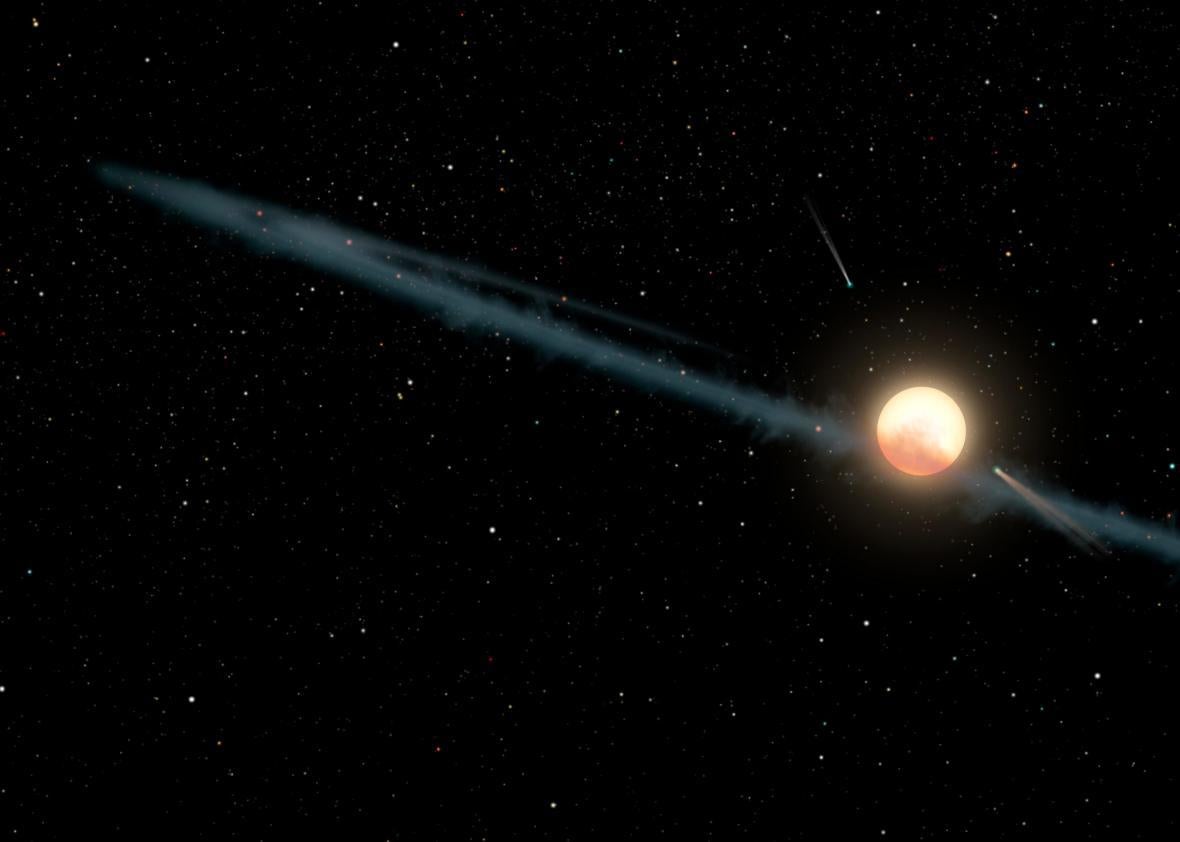If you’ve read the phrase alien megastructures over the past few years, you probably have Tabetha Boyajian to thank. The Louisiana State University–based astronomer has been the driving force behind investigating the mysteries of KIC 8462852, a little star 1,280 light-years away whose incredibly bizarre behavior has flummoxed scientists since October 2015. Boyajian and her colleagues worked furiously to figure out why observations of KIC 8462852 (affectionately called Tabby’s Star, after Boyajian), first made with NASA’s Kepler Space Telescope, showed the star was exhibiting insanely rapid, irregular dips in brightness.
Why was KIC 8462852 acting this way? Scientists didn’t know. It couldn’t be explained by conventional causes, like orbiting planets. Aliens were one theory, because of course they were. At some point, the theory that the dips might be caused by gigantic infrastructures built by an intelligent alien civilization started circulating. And from there alien megastructures really took off.
As the news spread, Boyajian took the unorthodox step of launching a Kickstarter campaign to fund new observations of the star, raising more than $100,000 from more than 1,700 online donors to reserve time to study KIC 8462852 with instruments operated by Las Cumbres Observatory.
Unfortunately, a new study published in Astrophysical Journal Letters put the alien megastructures dreams to rest. Whatever is causing Tabby’s Star to randomly dim like a lightbulb on the fritz has nothing to do with alien megastructures. In fact, it looks like the culprit is probably dust—maybe from the remnants of a nearby planet or moon, or from another source. Questions remain, and Boyajian and her team are anxious to learn more, but we can at least say for certain: Gigantic alien infrastructure is not at play here.
This revelation is a bit of a bummer, of course. And the crowdfunded nature of the project adds its own strange dimension to what happens next when it comes to investigating Tabby’s Star. Indeed, it raises interesting questions about how scientific investigations are supposed to proceed if they rely on public funding.
There are very clear advantages to crowdfunding scientific investigations. Sometimes it proves to be a useful way to raise money fast without trudging through the bureaucratic process that slows down traditional avenues. It can also bring the scientific and nonscientific communities closer and foster better communication and partnerships.
But the general public isn’t known for its patient foresight. People like bombastic spectacles; sexy, viral news; Boaty McBoatface. It’s hard to remember that an investigation into an obscure molecule could lead to a groundbreaking treatment for cancer two decades later, or how climate change is going to doom us all later this century. The pace of science and the pace of news are fundamentally at odds with each other.
Scientists, however, have to remember those things. So do the agencies that normally decide which projects deserve money. And perhaps more importantly, traditional institutions also have a healthy respect for the disappointment and surprise that permeates through research. When a hypothesis is disproven or something unexpected arises from the experiment, scientists don’t see failure; they see progress, just in a direction they hadn’t predicted before. Those results are still essential in filling gaps of knowledge, and they may prove useful later on.
Would Boyajian have really raised so much money if KIC 8462852 hadn’t generated so much hype about intelligent extraterrestrials? Both Boyajian and her colleague Jason Wright, an astronomer at Penn State University and co-author of the new study, and practically every other scientist studying the star made it adamantly clear the chances alien megastructures were orbiting the star were extremely small.
“I would be mortified if any one of the contributors thought that they were tricked into supporting the project because of E.T.,” Boyajian told Slate. “We worked very hard on clearly describing our intent to collect data to be used in testing any hypothesis.”
But one can’t help but suspect that many donors shelled out the cash for this project specifically in the hopes that the observations would prove the existence of aliens. People get hyped up about aliens, understandably—extraterrestrials are a serious part of space research these days. But it’s probably safe to say 1,700 people didn’t donate money in hopes of finding dust.
How can scientists keep their crowds interested after the crowdfunding? The key might be transparency. “I think the success of this project is a good template for others doing high-profile research to follow,” Wright told me. “Especially important has been the way that Tabby and her team have appreciated the backers, kept them involved, given them everything that was promised, and acknowledged their support.” He credits that work as the reason why some donors have already asked how they can contribute to follow-up studies, despite the dust finding.
Boyajian “absolutely” intends to pursue follow-up observations of KIC 8462852, but she isn’t sure whether many of the same contributors to the first Kickstarter campaign would come back in light of the fact that aliens have been ruled out. Can you raise $100,000 to study cosmic dust? Maybe. Boyajian’s challenge will be to market that investigation in a way that replicates the excitement of alien megastructures. That’s not a case that one would have to make to a panel of experts more familiar with and sensitive to the intricacies of scientific research.
